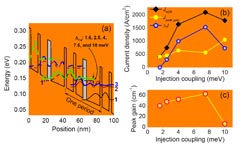Injection coupling in quantum-cascade lasers (Vol. 42, No. 5)
 (a) Typical conduction band structure of terahertz QCLs investigated here. The injection coupling (Δl'4) varies from 1.6 to 10 meV. The light grey regions represent doping layers. (b) Calculated JNDR, Jpeak gain and ΔJ as a function of injection coupling. (c) Peak gain for different injection coupling structures.
(a) Typical conduction band structure of terahertz QCLs investigated here. The injection coupling (Δl'4) varies from 1.6 to 10 meV. The light grey regions represent doping layers. (b) Calculated JNDR, Jpeak gain and ΔJ as a function of injection coupling. (c) Peak gain for different injection coupling structures.
High-performance quantum-cascade lasers (QCLs) emitting at terahertz frequencies are highly expected for some practical applications, such as imaging and sensing. Though mid-infrared QCLs operating in room temperature and continuous wave mode had been achieved, the wavelength extension to terahertz is pretty difficult due to the large free carrier absorption loss and small subband energy spacing. The performance improvements of terahertz QCLs need advances in active region and waveguide designs.
Recently the injection coupling parameter has attracted much interest because it not only affects the injection efficiency but also determines the laser gain shape and peak gain values. A density-matrix based calculation showed that a much stronger injection coupling (18 meV) should be employed for high performance mid-infrared QCL designs and the simulation has been verified by experiments.
Since the injection coupling plays an important role in the design and realization of high performance mid-infrared QCLs, it could also take effect in terahertz range. The research team investigated the effect of injection coupling strength on terahertz QCLs using an ensemble Monte Carlo method. An optimal injection coupling strength of 7.5 meV for dynamic lasing range and peak gain has been obtained for a 3.7-THz QCL. It is worth noting that the optimal injection coupling value is strongly dependent on the wavelength of the specific terahertz QCL design.
Effect of injection coupling strength on terahertz quantum-cascade lasers
H. Li and J.C. Cao, Semicond. Sci. Technol. 26, 095029 (2011)
[Abstract]







